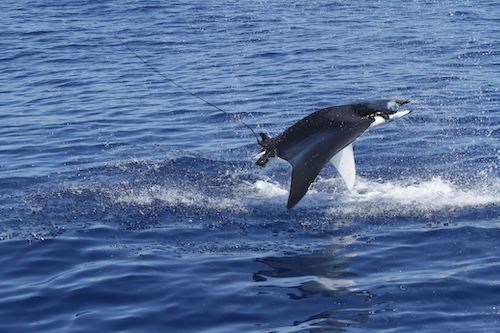Publication just released: Incidental catch of vulnerable species in Mediterranean and Black Sea fisheries – A review
For the first time, a review of all available data on the incidental catch of vulnerable species in Mediterranean and the Black Sea fisheries.

Bycatch – a term widely used to refer to the part of catch unintentionally captured during a fishing operation in addition to target species, and consisting of discards and incidental catches of vulnerable species – is considered as an important threat to the profitability and sustainability of fisheries, as well as to the conservation of the marine environment and its ecosystems.
Despite its pressure on the populations of vulnerable species, as well as the concern it represents for fishers, little is known of the scope of the problem.
Understanding bycatch and adopting effective measures to reduce it are essential steps towards minimizing the incidental catch of vulnerable species and, more generally, conserving the marine ecosystems, as well as ensuring a sustainable fishery sector.
For the first time, one single document compiles all available data and historical records on the incidental catch of vulnerable species in Mediterranean and Black Sea fisheries, in a standardized and comparable way.
Despite the scattered data available, this review confirms that incidental catches are, for some particular vulnerable species, fisheries and areas, significant, and therefore mitigation measures should be taken.
Each chapter in this review focuses on one of the five groups of vulnerable species, describing and presenting data taken from existing literature, databases, grey literature sources and studies conducted over recent decades
In continuation, you can find an example of the data that can be extracted from this review. Don’t hesitate to contact us to receive more targeted data or talk with one of our experts on:
- Seabirds
- Sea turtles
- Elasmobranchs
- Marine mammals
- Macrobenthic invertebrates
Data comparison at a regional level remains difficult, due to the absence of systematic and harmonized reporting of the incidental catch of vulnerable species. This work is a reminder of the importance of standardized data collection and of the need to have baseline information in order to support decision-making in the identification of appropriate bycatch mitigation techniques and the implementation of conservation and management measures at the national, subregional and regional levels. With this goal in mind, the GFCM is collaborating with ACCOBAMS, BirdLife Europe and Central Asia, IUCN-Med, MEDASSET, SPA/RAC, WWF-Med, to develop the Medbycatch project that aims to monitor and mitigate incidental catches of vulnerable species and reduce fishing impacts and pressures on marine habitats and species.
ZOOM ON ELASMOBRANCHES
Sharks, rays and skates

©Alessia Scuderi/Tethys Institute
|
Example of the data available in the report Conservation-priority elasmobranch bycatch come from: 55% longliners 18% small-scale fisheries 13% bottom trawlers 11% pelagic trawlers 3% purse and tuna seiners |
Mediterranean and Black Sea ecosystems count at least 48 species of sharks and 38 species of rays and skates. |
For elasmobranchs, their life cycle (e.g. low population growth rates, late sexual maturity), associated with their low resilience to fishing pressure, are among the main reasons for the concerning decline of population observed in most of the world’s seas, including the Mediterranean and the Black Sea.
The majority of available data point to individuals caught as bycatch by several types of gear, sometimes in greater numbers and biomass than the target commercial species. As a result, many sharks are discarded at sea or landed to be sold, including protected species. Due to incidental catch, many Mediterranean shark species are locally disappearing from areas in which their presence has been historically commonly recorded.
|
DOWNLOAD HERE Incidental catch of vulnerable species in Mediterranean and Black Sea fisheries: A review |
|
Further reading:
|
